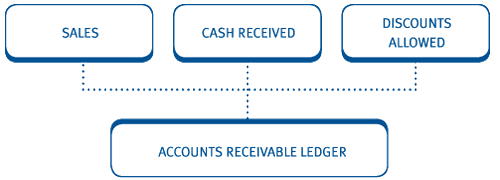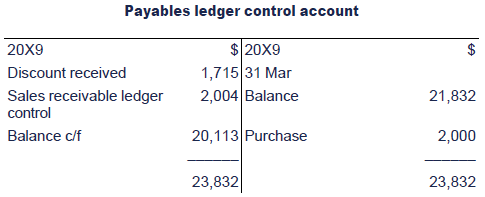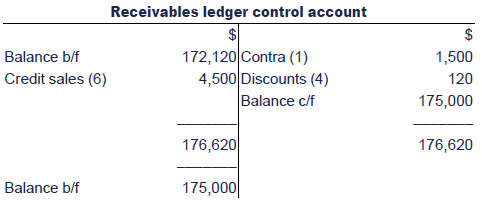Chapter 11: Control account reconciliations
Chapter learning objectives
Upon completion of this chapter you will be able to:
- prepare, reconcile and understand the purpose of supplier statements
- identify errors which would be highlighted by performing a control account reconciliation
- perform basic control account reconciliations for receivables and payables, identifying and correcting errors in control accounts and ledgers.
1 Control accounts

- Control accounts are a means of proving the accuracy of the ledger accounts, such as receivables and payables.
- The diagram above shows the information that is included in the accounts receivables ledger.
- If we wanted to check the accuracy of the accounts receivables ledger, one way we can do this is by getting the information from different sources:
- The sales can be taken from the sales day book.
- The cash received and discounts allowed are recorded in the cash book.
- The opening balances can be taken from the prior month’s closing balances.
- An alternative way to check the accuracy of the accounts receivables ledger is to compare the sum total of the individual receivables accounts with the balance on the receivables ledger control account.
- Remember, the control account is normally part of the double entry system, whereas the ledger contains memorandum accounts which are not part of the double entry system. Nevertheless, both are updated using the same sources and therefore should agree.
2 Supplier statements
These statements are issued to a business by suppliers tosummarise the transactions that have taken place during a given period,and also to show the balance outstanding at the end of the period.
- Their purpose is to ensure that the amount outstanding is accurate and agrees with underlying documentation.
- The payables (individual) ledger account should agree with the total of the supplier statement.
- As such, these are a further way to prove the accuracy of accounting records.
Supplier statement reconciliations
It is also possible to reconcile a supplier statement to the control account.
The purpose for doing this is as follows:
- before any payments are made to suppliers it is important to ensure that the suppliers statement is correct – else we could make over or under payments.
- each invoice and credit note listed on the statement should be checked to the original documentation for accuracy.
- once accuracy has been established, it is then possible to decide which invoices need paying and when by.
Below is an example extract of a statement from a supplier:

Here is the payables ledger which corresponds with this supplier:

You can see that the invoice dated 4 July 20X9 in the ledger is of atotal $110.99, however in the statement it appears as $101.99.
The purchase invoice itself should be reviewed to check which isthe correct amount. If the suppliers statement is incorrect, then apolite telephone call to the supplier should be made or a letter sentexplaining the problem.
If it is the ledger that is incorrect then it should be updated.
3 Control account reconciliations
The reconciliation is a working to ensure that the entries in theledger accounts agree with the entries in the control account. The twoshould have the same closing balance as ideally they have had exactlythe same entries in both accounts.
- A receivables ledger reconciliation compares the total of the accounts in the receivables ledger with the balance on the receivables ledger control account.
- A payables ledger reconciliation compares the total of the accounts in the payables ledger with the balance on the payables ledger control account.
If there are differences between the control account and the ledgeraccounts, they must be identified and reconciled. Differences may arisedue to:
- errors in the receivables or payables ledger
- errors in the receivables or payables ledger control accounts
- errors in both the control account and ledger account.

 Test your understanding 1
Test your understanding 1
Suggest reasons why there might be a difference between thebalance on the receivables ledger control account and the total of thelist of accounts receivable ledger balances.

4 Preparing a control account reconciliation
The format of a control account reconciliation, in this case for sales is as follows:

Reconciliation of individual receivables balances with control account balance

- The examiner will provide details of the error(s).
- You must decide for each whether correction is required in the control account, the list of individual balances or both.
- When all errors have been corrected, the revised balance on the control account should agree to the revised total of the list of individual balances.
- Due to the nature of the F3/FFA exam, you will not be asked to produce a full control account reconciliation, however you may be asked for the revised balance on the control account / list of individual balances after one or two errors have been corrected.

 Illustration 1 – Preparing a control account reconciliation
Illustration 1 – Preparing a control account reconciliation
Alston’s payables ledger control account is an integral part ofthe double entry system. Individual ledger account balances are listedand totalled on a monthly basis, and reconciled to the control accountbalance. Information for the month of March is as follows:
(1) Individual ledger account balances at 31 March have been listed out and totalled $19,766.
(2) The payables ledger control account balance at 31 March is $21,832.
(3) On further examination the following errors are discovered:
- The total of discount received for the month, amounting to $1,715, has not been entered in the control account but has been entered in the individual ledger accounts.
- On listing-out, an individual credit balance of $205 has been incorrectly treated as a debit.
- A petty cash payment to a supplier amounting to $63 has been correctly treated in the control account, but no entry has been made in the supplier’s individual ledger account.
- The purchases day book total for March has been undercast (understated) by $2,000.
- Contras (set-offs) with the receivables ledger, amounting in total to $2,004, have been correctly treated in the individual ledger accounts but no entry has been made in the control account.
(i) Prepare the part of the payables ledger control account reflecting the above information.
(ii) Prepare a statement reconcilingthe original total of the individual balances with the corrected balanceon the control account.


 Solution
Solution
Solution
The best way to approach the question is to consider each of thepoints above in turn and ask to what extent they affect (i) the payablesledger control account and (ii) the listing of payables ledgerbalances.
Step 1
The total of discount received in the cash book should have beendebited to the payables ledger control account and credited to discountreceived. Thus, if the posting has not been entered in either doubleentry account it clearly should be. As this has already been enteredinto the individual ledger accounts, no adjustment is required to thelist of balances.
Step 2
Individual credit balances are extracted from the payablesledger. Here, this error affects the ledger accounts balance. Noadjustment is required to the control account, only to the list ofbalances.
Step 3
The question clearly states that the error has been made in theindividual ledger accounts. Amendments should be made to the list ofbalances. Again, no amendment is required to the control accounts.
Step 4
The total of the purchases day book is posted by debitingpurchases and crediting payables ledger control account. If the total isunderstated, the following bookkeeping entry must be made, posting the$2,000 understatement:
Dr Purchases
Cr Payables ledger control account
As the individual ledger accounts in the payables ledger are postedindividually from the purchases day book, the total of the day bookbeing understated will not affect the listing of the balances in thepayables ledger.
Step 5
Here it is clear that the error affects the control account, notthe payables ledger. Correction should be made by the bookkeeping entry:
Dr Payables ledger control account
Cr Receivables ledger control account

Reconciliation of individual balances with control account balance



 Test your understanding 2
Test your understanding 2
Rayneydaze is a business selling umbrellas branded with corporatelogos. The umbrellas are sold in bulk lots on credit. The accountant iscarrying out a reconciliation of the receivables ledger control accountbalance, which is $172,120 to the total of the balances on theindividual accounts in the receivables ledger, which is $176,134.
The following has been found:
(1) A contra item of $1,500 has not been entered in the receivables ledger control account.
(2) A cheque for $555 from a customerhas been dishonoured. The correct double entry has been posted but theindividual accounts have not been updated.
(3) A payment of $322 from a customer has incorrectly been entered in the accounts receivable ledger as $233.
(4) Discounts allowed totalling $120 have not been entered in the control account.
(5) Cash received of $800 has been debited to the individual customer’s account in the accounts receivable ledger.
(6) Total credit sales of $4,500 to alarge accountancy firm, Close & Counter have been posted correctlyto the ledger account but not recorded in the control account.
Correct the receivables ledger control account and reconcile thisto the sum total of the individual accounts in the accounts receivableledger.


 Test your understanding 3
Test your understanding 3
Tonga received a statement from a supplier, Cook, showing abalance of $14,810. Tonga’s Payables ledger shows a balance due toCook of $10,000. Investigation reveals the following:
(1) Cash paid to Cook of $4,080 has not been allowed for by Cook.
(2) Tonga’s recorded the fact that a $40 cash discount was not allowed by Cook, but forgot to record this in the payables ledger.
What discrepancy remains between Tonga and Cook’s records after allowing for these items?
A $9,930
B $9,850
C $770
D $690

Chapter summary
Test your understanding answers

 Test your understanding 1
Test your understanding 1
The following are reasons why the accounts receivable control account may not agree with the ledger account:
- The sales day book, sales returns day book or cash receipts book have been incorrectly totalled.
- A total from a book of prime entry has been transferred to the control account as a different figure.
- An individual entry from a book of prime entry has been transferred to the individual customer’s account as a different figure.
- An entry in the control account or the individual customer’s account has been omitted or posted to the wrong side of the account.
- The double entry for a day book total has been incorrectly made.
- An individual customer’s account has been incorrectly balanced.
- The list of accounts receivable ledger balances has been incorrectly totalled.
- An entry has been made in either the control account or the individual customer’s account but not in both.
- An individual customer’s balance has been omitted from the list of balances.


 Test your understanding 2
Test your understanding 2

Receivables ledger reconciliation



 Test your understanding 3
Test your understanding 3
The correct answer is D.


|
Created at 5/24/2012 3:35 PM by System Account
(GMT) Greenwich Mean Time : Dublin, Edinburgh, Lisbon, London
|
Last modified at 5/25/2012 12:53 PM by System Account
(GMT) Greenwich Mean Time : Dublin, Edinburgh, Lisbon, London
|
|
|
|
 |
Rating
:
|
 Ratings & Comments
(Click the stars to rate the page) Ratings & Comments
(Click the stars to rate the page)
|
 |
Tags:
|
|
|
|
|